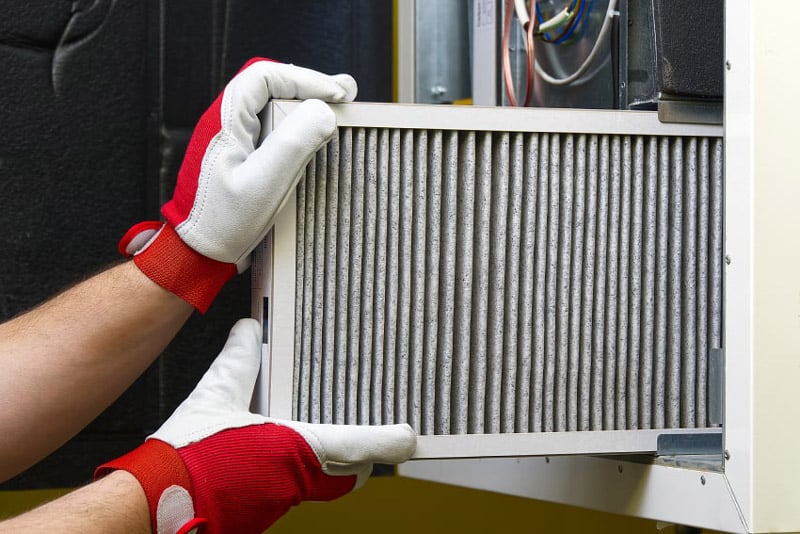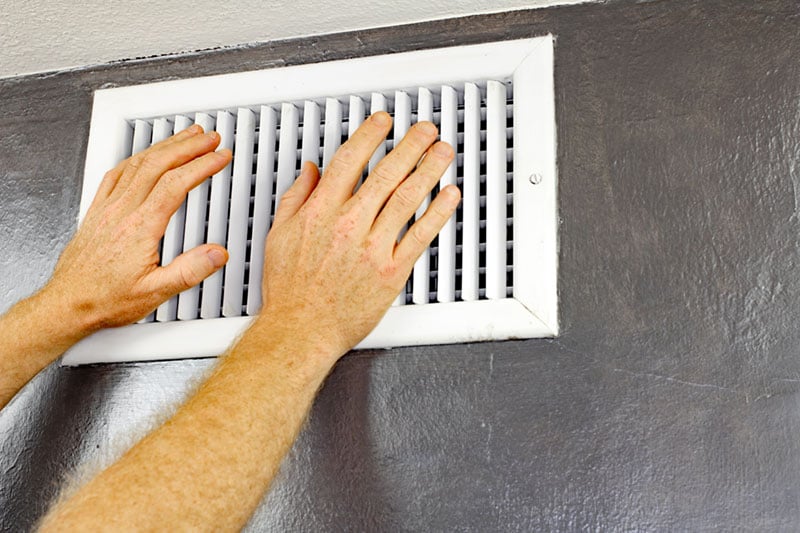Are you struggling with a locked-out furnace?
That sucks! I understand how annoying it can be when your furnace isn’t working, especially when your home is freezing.
Luckily, you’ve come to the right place for answers.
To get your locked-out furnace back on, you’ll need to replace the air filter, check for airflow issues, and clean the flame sensor. It’s also important to examine the igniter and limit switch.
Read on to learn how to get your furnace working again!
Getting Your Furnace Out of Lockout Mode: 5 Steps
If one of the internal components isn’t functioning properly, your furnace will enter lockout mode to ensure your safety and signal that something is wrong.
Don’t worry, though. In this section, I’ll guide you through the five steps you must follow to inspect your furnace and get it working again.
Keep in mind that fixing the problem will require accessing certain internal components, so having the manufacturer’s manual handy is crucial.
Are you ready? Let’s get started!
#1 Replace the Air Filter
When fixing a locked-out furnace, I always start by checking the air filter.
The air filter captures dust, dirt, dander, and other allergens to prevent them from entering your furnace and affecting air quality.
Unfortunately, if you haven’t changed the filter in a while, it can cause airflow issues. As a result, your furnace will overheat and enter lockout mode to prevent potential safety issues.

Replacing your furnace’s air filter is very simple. You’ll just need to:
- Turn off your furnace and remove the panel to access the air filter, which is typically located in front of the fan or on the vent. Keep in mind that the exact location can vary depending on your furnace’s model, so please refer to the owner’s manual.
- Carefully remove the old filter.
- Purchase a compatible filter.
- Insert the new filter into its housing, ensuring it aligns with the furnace’s airflow.
Once you’ve replaced the air filter, please reset your furnace to get it out of lockout mode. To do so, simply turn it off at the circuit breaker, wait for a couple of minutes, and turn it back on.
#2 Check for Airflow Issues
If you’ve replaced the air filter but your furnace is still on lockout mode, then you’ll need to check for airflow issues.
When the vents or ducts become obstructed, they can disrupt airflow and cause your furnace to overheat. As a result, the unit will shut down to prevent the release of harmful gases, such as carbon monoxide.
To check for airflow issues, ensure there are no items, such as furniture or curtains, blocking the vents in each room. While you’re at it, it’s also important to clean the vent covers using a soft sponge or brush.

Then, turn off the furnace and use a flashlight to examine the ductwork. If you notice any air leaks, you can seal them using mastic sealant or metal tape. Don’t forget to remove any obstructions or debris to fix the airflow issue.
It’s worth noting that accessing and cleaning the ductwork can be a bit challenging, especially if you’re not an experienced DIYer. If necessary, consider calling an HVAC technician for assistance.
After checking for airflow issues, remember to reset your furnace to get it out of lockout mode.
#3 Clean the Flame Sensor
In my experience, a dirty flame sensor can also cause a furnace to enter lockout mode.
The flame sensor is a safety device that monitors the presence of a flame when the gas valve is open. If the sensor is dirty or malfunctioning, it won’t detect the flame and assume unburned gas is being released. As a result, the flame sensor will signal the furnace to shut off the gas valve and enter lockout mode to ensure your safety.
Luckily, cleaning the flame sensor is very simple. Here’s how:
- Turn off your furnace at the circuit breaker and shut off the gas supply.
- Remove the access panel using a screwdriver. If necessary, refer to the manufacturer’s manual.
- Locate the flame sensor, which is typically near the burners. It has a metal rod with a porcelain insulator and a single wire attached.
- Remove the screws holding the flame sensor in place.
- Clean the flame sensor using fine steel wool. Be careful not to scrub the sensor to prevent damaging it.
- Look for any visible signs of damage. If necessary, get a compatible replacement.
- Place the flame sensor back in its place.
After cleaning the flame sensor, restore power and gas to your furnace and check if the issue has been solved.
#4 Examine the Igniter
If your furnace is still on lockout mode, it’s time for us to examine the igniter.
The igniter is one of the most important components in your furnace, as it ignites the gas that enters the combustion chamber. If the igniter is not working, it won’t generate a flame and your furnace will detect the presence of unburned gas. To prevent potential safety issues, the unit will go into lockout mode.
To solve the problem, turn off your furnace at the circuit breaker, shut off the gas supply, and remove the access panel. Then locate the igniter, which is typically near the burners or in the combustion chamber. Look for any visible signs of damage, such as cracks. If necessary, get a compatible replacement.
If the igniter seems to be in good condition, my usual advice is to test it with a multimeter. To do so, set your multimeter to the lowest setting for ohms of resistance and remove the component.
Then, use a multimeter’s probe to touch one of the igniter’s terminals and the second probe to touch the remaining terminal. The multimeter should display a reading between 50 and 400 ohms of resistance (or the manufacturer’s recommended values). If it the display doesn’t change significantly, you’ll need to replace the igniter.
Once you’ve tested or replaced the igniter, remember to reset your furnace.
#5 Check the Limit Switch
If you’ve tried all the fixes mentioned in this article, but you’re still struggling with a locked-out furnace, I recommend inspecting the limit switch.
The limit switch monitors the temperature of the air passing over the heat exchanger. If it gets too hot, the switch will shut off the burners to prevent overheating. However, if the switch is faulty, it can trigger a lockout even when it’s not needed.
To test the limit switch, you’ll need to:
- Turn off your furnace at the circuit breaker and shut off the gas valve.
- Remove the access panel and locate the limit switch. Remember to read the manufacturer’s manual, as the exact location can vary depending on the furnace model you own.
- Take a picture of the wires for future reference and carefully disconnect them.
- Remove the limit switch from the furnace and set your multimeter to the lowest setting for ohms of resistance.
- Touch the multimeter’s probes to each terminal of the limit switch and check the displayed reading.
- If the multimeter shows no continuity or infinite resistance, you’ll need to replace the limit switch with a new one.
- Once you’ve replaced the limit switch, reassemble your furnace and turn it back on at the circuit breaker. Don’t forget to turn on the gas valve as well.
Remember that if you’re uncomfortable testing or replacing the limit switch yourself, it’s best to call a professional. They have the required tools and expertise to diagnose and fix the issue safely.
Wrapping Up: Reigniting Your Furnace
Hopefully, now you know how to get your locked-out furnace back on.
Remember, to get your furnace out of lockout mode, you’ll need to ensure proper airflow and clean the flame sensor. Don’t forget that it’s also important to test the igniter and limit switch. Purchase any necessary replacements.
Thank you so much for taking the time to read this article. If you’ve found it helpful, please check out our other related guides below.
Have a great rest of the day!









